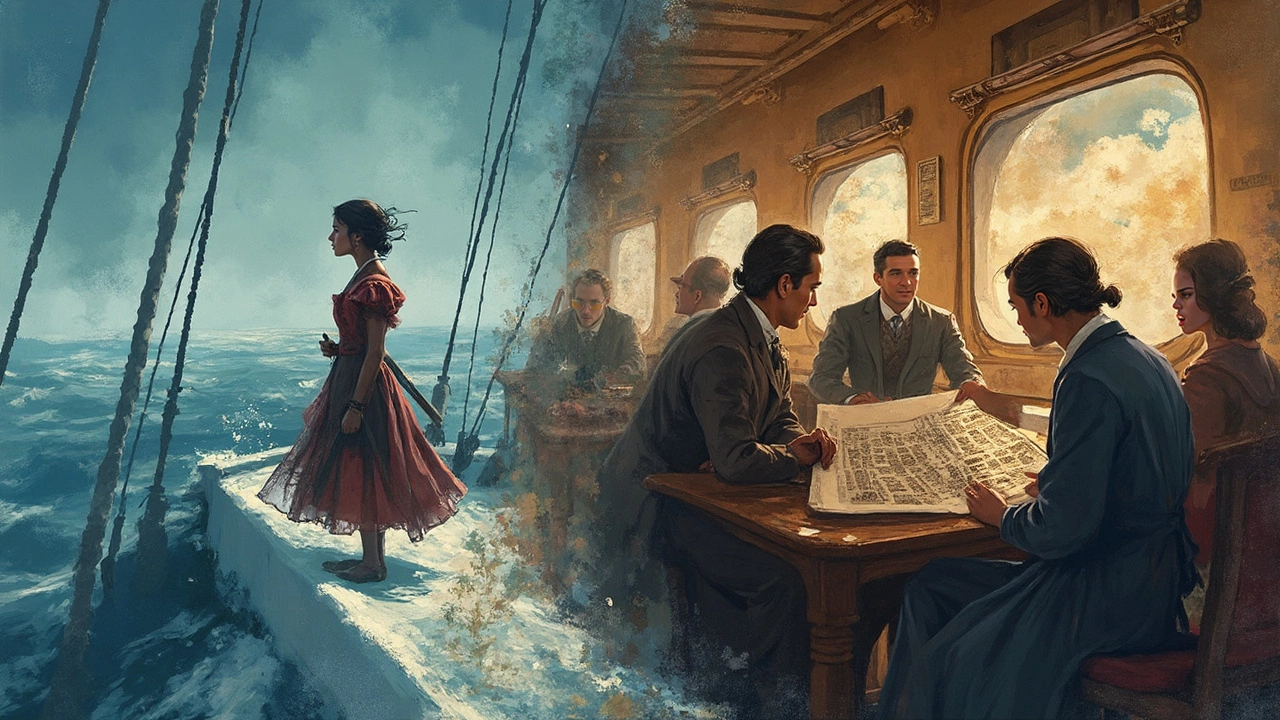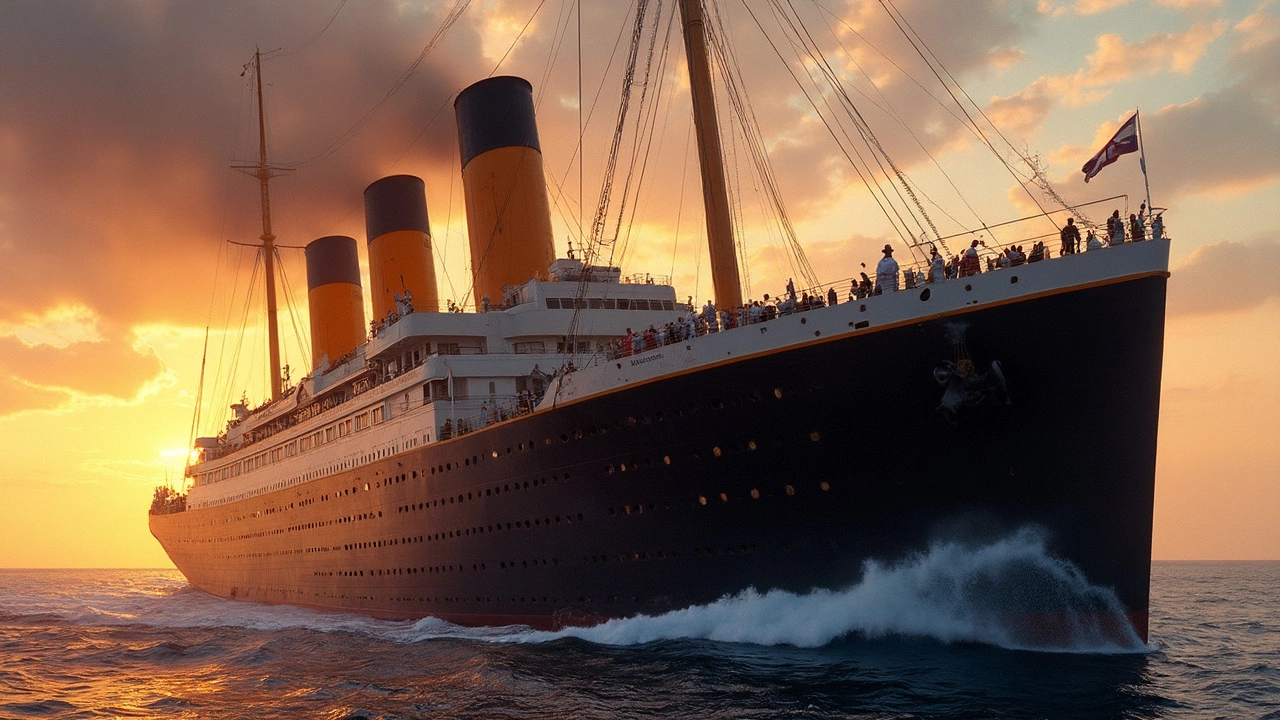The 1997 Titanic movie is one of those films everyone seems to know, whether you’re a die-hard Leo and Kate fan or just enjoy a rainy-night rewatch. But did you ever wonder how much of that drama really happened? Was Jack real? Did the ship really sink like that? People love to argue about what was true and what was just movie magic.
If you want to separate legend from fact, it helps to start with the basics. The Titanic was a real ship, it really hit an iceberg, and over 1,500 people genuinely lost their lives. So yeah, the heart of the story isn’t made up. The film went to extreme lengths to recreate the look of the ship—right down to the decor, furniture, and even the plates. Historians worked with James Cameron to make some of those background details spot-on.
But there’s a big gap between getting the wallpaper right and telling the honest, historical story. It’s easy to watch those famous scenes—Jack and Rose at the bow, the panicked musicians, the villainous crew—and just assume they happened. The real question is, what’s the deal with all the little details in between?
- What Titanic Got Right
- Where the Movie Twists History
- Characters: Real vs. Fiction
- Spotting Truth During Your Rewatch
What Titanic Got Right
For all its blockbuster drama, the 1997 Titanic really nailed a lot of historical details. Right out of the gate, the film’s biggest win is its accuracy with the ship itself. James Cameron’s crew used original blueprints and vintage photos to rebuild the ship down to the tile on the floor and the patterns on the china. If you look closely, almost everything you see—the dining rooms, grand staircase, and even the lifeboats—matches what’s been documented by real photos and survivor testimony.
That famous iceberg scene isn’t just Hollywood magic. The timeline of the impact, how the iceberg scraped the starboard (right) side, and even the confusion on deck, line up with actual accounts from the night of April 14, 1912. You’ll notice the crew’s actions—like why they didn’t fill the lifeboats right away or why the ship kept moving forward for a while after the hit—all check out according to reports from the British investigation.
The split of the ship? That dramatic final snap was debated for years, but in the end, the movie got it right. The wreck discovered in 1985 confirmed the ship broke in two before it sank, just like Cameron depicted. Even the way the band played while the ship was going down is based on several survivor stories. They really did try to keep people calm with music until the end.
Take a look at the numbers. Here’s a quick breakdown of some real facts the movie nailed:
| Fact | What the Movie Showed |
|---|---|
| Number of lifeboats | 20 (accurate) |
| Total passengers and crew | About 2,200 (movie is close) |
| SOS distress calls | Used correctly in the script |
| Class distinctions on board | Shown clearly throughout |
So if you want to spot truth while watching Titanic 1997, focus on the ship, the sinking process, the stuff in the background, and the general timeline. Even hard-to-please maritime experts usually give the film credit for that much.
Where the Movie Twists History
Here's what most folks miss: for all its gripping drama, Titanic 1997 bends the truth in some big ways. First off, Jack and Rose—those two never existed. They're pure Hollywood fiction, meant to pull you into the story. There was no record of a "Rose DeWitt Bukater" or "Jack Dawson" in any real passenger list. The filmmakers even admit these two were invented for storytelling punch.
Think of the villain—Cal Hockley. In real life, there wasn’t a snobby fiancé chasing anyone with a gun below decks. Also, the scene with the ship's crew locking third-class passengers behind gates? That's much more dramatic than what most survivor stories tell. While there were some restrictions (and class bias was real), the locked-gate scene is exaggerated for suspense.
The movie also makes the ship’s sinking a super-fast, edge-of-your-seat disaster. In reality, it took about 2 hours and 40 minutes for the ship to fully go down. Not everything was explosions and chaos every second. People did panic and there was confusion, but the timeline was far less action-packed than what you see on screen.
Hollywood loves a clear villain, but the ship’s First Officer William Murdoch—shown taking bribes and shooting passengers—was probably nothing like his movie version. There’s no real evidence he acted corruptly; survivors gave him better marks for bravery.
Musicians playing as the ship sank? That part is true, but the exact last song is still up for debate. The film claims "Nearer, My God, to Thee" played as the ship vanished, but a few survivors remembered different tunes.
- Titanic 1997 skips some lifeboat details. A lot more lifeboats could’ve held more people, but launched half-empty out of confusion, not just laziness or cowardice.
- The movie makes Molly Brown look like an outsider. Actually, "The Unsinkable Molly Brown" was fairly accepted by other first-class passengers, not the social outcast the film paints her as.
And when it comes to the "draw me like one of your French girls" scene, sorry—not a shred of historical evidence for that one. That sketchbook never existed.
| Event | Movie Version | Historical Record |
|---|---|---|
| Jack & Rose | Central movie love story | No evidence they existed |
| Sinking Speed | Nonstop chaos | Took nearly 3 hours |
| Locked Third-Class Gates | Full gate barriers, people trapped | Partial restrictions, not full lock-in |
| William Murdoch's Role | Shoots passengers, takes bribes | No proof, seen as a hero by survivors |
So, while Titanic 1997 nails the visuals and captures the heartbreak, don’t take every scene as word-for-word history. Next time you watch it, you’ll spot these twists right away.

Characters: Real vs. Fiction
If you’ve ever wondered which faces from the 1997 Titanic movie actually walked the real decks, the truth is pretty mixed. The film blends real people with made-up ones to ramp up the drama, but some names are straight from history while others are pure Hollywood.
Let’s start with the obvious: Jack Dawson and Rose DeWitt Bukater are totally fictional. There was no record of a "Jack and Rose" love story on board. James Cameron made them up to guide viewers through the chaos, even though plenty of real-life couples were on the ship—their stories just weren’t as photogenic or tragic.
But a bunch of supporting characters do come from the actual disaster. Here are some big ones you might recognize from both the movie and real history:
- Captain Edward Smith: He was the real captain, and he really did go down with his ship.
- Molly Brown: Famously called "The Unsinkable Molly Brown," she survived and even tried to rally her lifeboat’s crew to rescue more people. Kathy Bates played her on screen, and she’s easily one of the most accurate portrayals.
- J. Bruce Ismay: The White Star Line’s chairman, seen sneaking onto a lifeboat in the movie, did escape the sinking. Historians still argue about just how shady his actions really were.
- Thomas Andrews: The ship’s designer really was on board. He did try to help save passengers and ultimately died in the disaster.
Also, those musicians playing as the ship sank? That’s true. The bandleader, Wallace Hartley, and his fellow musicians kept performing until the end. The scene with them playing "Nearer, My God, to Thee"? There are conflicting reports, but most survivors remember the music.
For a quick reality check, here’s a handy table that sorts out who’s real, who’s kind of real, and who’s made for the script:
| Character | Real? | Role in Film |
|---|---|---|
| Jack Dawson | No | Main love interest |
| Rose DeWitt Bukater | No | Main love interest |
| Captain Edward Smith | Yes | Captain of Titanic |
| Molly Brown | Yes | Socialite, survivor |
| J. Bruce Ismay | Yes | Company chairman |
| Thomas Andrews | Yes | Ship’s designer |
| Cal Hockley | No | Rose’s fiancé, villain |
The made-up characters, like Cal (the jealous fiancé) and Ruth (Rose’s strict mom), are there to make the story pop. They don’t match any real person from the Titanic passenger roster. If you want the truth, stick to the names you see above. The rest? Enjoy the drama, but don’t take them for history.
Spotting Truth During Your Rewatch
Next time you sit down for a Titanic movie night, you can spot real history mixed in with Hollywood storytelling. Some details are actually on point, while others were added just to boost the drama. Here’s how you can separate them without hitting pause every five minutes.
- Ship Design: Take a closer look at the grand staircase, the first-class dining room, and the lifejackets. The Titanic 1997 team used original blueprints, so what you see is almost exactly what passengers did back in 1912. Even the menu in the first-class dinner scene matches what survivors described.
- Iceberg Collision: The film nailed the basics—Titanic did hit the iceberg late at night, scraping along the starboard side. The panic and chaos as water floods in? That’s real. But in reality, things got bad a lot slower than the frantic movie scenes suggest.
- Musicians: Remember the band playing “Nearer, My God, to Thee”? That’s straight from survivors’ reports. The musicians really did keep playing to calm everyone down, even as the ship was sinking.
- Eerie Details: That wireless operator who stays at his post? Spot on. Wireless operators Jack Phillips and Harold Bride stayed almost to the end, sending SOS messages.
If you love to fact-check as you go, you’ll find some gems. But not everything is perfectly accurate:
- The movie shows the ship splitting in half high up in the air before sinking, which ties in with earlier research. Modern dives show the break happened more at the surface, and didn’t launch the stern as high as in the film.
- The third-class gates actually existed, but survivors said they weren’t locked. The movie ups the drama by making it look like steerage passengers had no way out.
Want some cold, hard numbers to keep in mind as you watch? Here’s a quick comparison:
| Detail | Movie | Reality |
|---|---|---|
| Fatalities | ~1,500 | 1,496 |
| Time to Sink | About 2 hours 40 min | 2 hours 40 min |
| Lifeboats Used | Not enough | Only 20 (for 1,178 people) |
| Main Characters | Jack & Rose: fictional | No real record |
If you spot the details above, you’ll enjoy the Titanic 1997 movie with fresh eyes—and impress your friends by pointing out what’s legit and what’s just movie magic.

